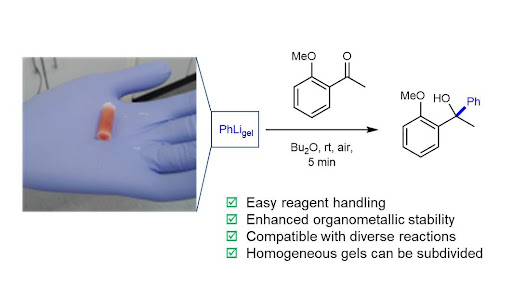Using Gels to Tame Highly Reactive Chemicals
Scientists from the Department of Chemistry in York have developed an innovative way of using gels to stabilise highly reactive organometallic chemicals. This enhances safety and could transform the way chemical reactions are carried out.

Organometallic reagents are a vital tool in modern chemistry allowing the creation of new carbon-carbon bonds and underpinning the synthesis of vital products such as pharmaceuticals and polymers. However, due to the high reactivity of many organometallics, low temperatures, inert atmospheres and strictly dried solvents are usually necessary. As a result, a high level of training and expertise in specialist methods is required for those who use such reagents, and their storage and transportation are challenging and expensive.
In their newly-published research a team led by Professors David Smith and Peter O’Brien have reported a new encapsulation approach to stabilise sensitive organometallic reagents.
Reactive organometallics based on either lithium or magnesium were mixed with a low-cost hydrocarbon capable of forming a self-assembled gel. As the gel formed, the organometallic reagent became stabilised. The researchers found that reagent lifetime was significantly extended by protection within the gel, which allowed simple handling, delivery and storage, and enabled reproducible reagent portioning. In some cases, the gels could even be held in the hand, exposed to air, before dosing into a reaction vessel.
Team members Dr Petr Slavik and Benjamin Trowse demonstrated the ability of the gels to be used in a wide range of different organic reactions of high value both in industry and in the research community. Reactions proceeded in the absence of all the usual restrictions required for air-sensitive reagents. The purification protocols were simple and gave the desired products in high yields.
Reflecting on the work Professor Smith said: “Storing and using highly-reactive chemicals is one of the most challenging aspects of synthetic chemistry, yet is vital to help produce essential products such as pharmaceuticals. We plan to commercialise this approach to gel-stabilised organometallics so that researchers can benefit from the advantages in terms of safety and handling.“
Professor O’Brien added: “By making reaction set-up much more straightforward, these gels have the potential to lower the barrier to doing chemical reactions, making them more accessible to a wider range of researchers. By enhancing storage and lifetime, the use of these reagents becomes more sustainable and cost-effective, which would be attractive in both academic and industrial settings. We are looking forward to extending our approach to organometallics based on different metals, as well as other types of air-sensitive reagents.”
In their current work, the team are now extending their approach to organometallics based on different metals, as well as other types of air-sensitive reagents – safe and easy use of a wide range of different reactive chemicals could potentially be enabled using this approach.
The paper is published in Nature Chemistry.